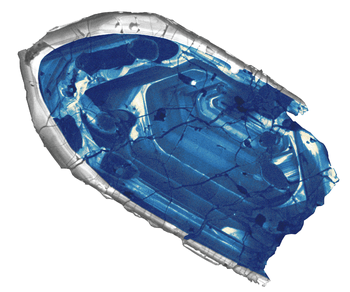
Last week I visited my aunt in Salem, Oregon. Her husband grows massive amounts of marijuana and she talked at length about her recent fascination with books that discuss the effects of WWII without focusing on the Holocaust. She claims she does not like to hear about that negative part of our history, but does want to understand it. So she reads around it, like a negative space drawing.
While I was there she showed me her rock collection.
"This one is a dinosaur bone," she said, holding one out.
I have seen many fossils, including those of 500 million year old Cambrian trilobites preserved in the Burgess Shale, and I could not help giving her a little lesson.
"Well, it's not actually a bone," I said. "It's a rock."
"What do you mean?" She asked.
"It's a fossil that formed in the void left behind by a buried dinosaur bone."
She remained skeptical. After all, it looked like a bone. Moving on in the collection she showed me some petrified wood.
"This is also a rock," I told her. Seeing that she wanted to know more, I expounded: "Consider its weight: if it is made of wood, then how is it so dense?"
The phrase 'petrified wood' is a misnomer. It is actually a type of fossil that forms thorough a process called permineralization, in which minerals seep into plant remains, gradually replacing organic matter with stone. The result is an internal cast that preserves the original shape of the plant tissue. This striking similarity in shape and texture is no doubt why this particular fossil has retained the name of its biological antecedent.
Eventually my aunt came around and started believing in fossils. The truth is, because water and atmosphere are in constant motion, and organic matter rapidly decays, only rocks exist long enough to tell stories from hundreds of millions of years ago.
Geologists are scientists who know how to interpret the rock record, and the main contributors to our knowledge of the early Earth. In 2001 a team working in the Jack Hills in Western Australia discovered a 4.4 billion year old zircon crystal, the oldest known terrestrial object. The composition of each zircon is a signature unique to the conditions under which it formed. This one indicated that at 100 million years old the Earth was already cool enough to have liquid water. [1] It is conceivable that this relatively hospitable environment was the setting of the first chapter in the history of life on Earth.
[1] Valley, John W., et al. "A cool early Earth." Geology 30.4 (2002): 351-354.
See also:
https://en.wikipedia.org/wiki/Cool_early_Earth
https://en.wikipedia.org/wiki/Jack_Hills
Well written
Congratulations @uhbm! You have received a personal award!
Click on the badge to view your own Board of Honor on SteemitBoard.
For more information about this award, click here
Congratulations @uhbm! You have received a personal award!
Click on the badge to view your Board of Honor.
Congratulations @uhbm! You received a personal award!
You can view your badges on your Steem Board and compare to others on the Steem Ranking
Do not miss the last post from @steemitboard:
Vote for @Steemitboard as a witness to get one more award and increased upvotes!